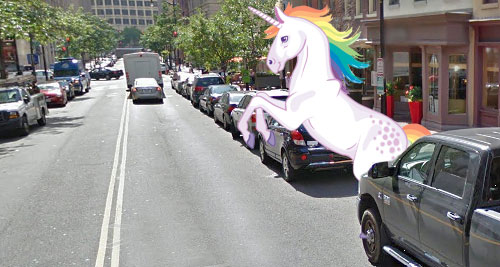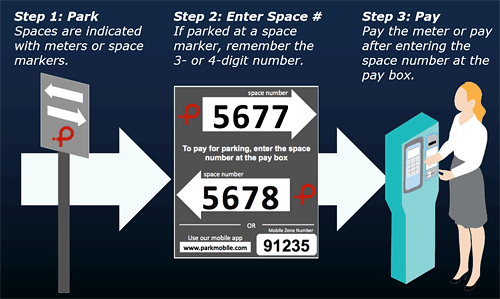It’ll soon be easier to find a parking space in Chinatown
It can be tough to drive in DC — there’s congestion, motorcades, and “parking signs harder to decipher than CIA code — that is, if you can find an open spot.” DC can’t do much about motorcades, but a new pilot program will help drivers find places to park and even cut down on congestion, though recent news coverage has sown confusion.

This parking pilot will make spaces easier to find than unicorns. Photo of D Street NW from Google Maps; unicorn image from Shutterstock.
There’s no free lunch, to be sure; an easy-to-find spot will cost somewhat more than a spot today. However, if you try to park on the street in the Gallery Place/Chinatown area of DC today at a busy time, you might be circling for 20 or 30 minutes. This program will make parking much more predictable and less stressful.
What’s this parking pilot?
DC is running an experiment, called ParkDC, based on a successful pilot in San Francisco and similar programs elsewhere. There, as here, parking on the street is extremely difficult to find at busy times, but is far, far cheaper than in a garage.
Because of this, people end up circling for 10, 20, 30 minutes looking for the elusive cheap space, and in doing so, add considerably to traffic congestion, not to mention getting frustrated.
People who need to run a quick errand or drop something off can’t park, and since garages generally gear their pricing toward all-day or all-evening parkers, it’s very pricey to park for a very short time.
The solution is obvious, at least if you’re an economist: Price parking according to supply and demand. Raise the price when demand is high, and drop it when it’s low.
This encourages people who want to park for a long time to use a garage, while giving people who need quicker and shorter parking a chance. Reduce the circling and speed up traffic for everyone.

A map of where ParkDC will go into effect. Image from DDOT.
The District Department of Transportation (DDOT) is running this as an experiment, with money from the Federal Highway Administration, to see if it’s possible to accurately gauge the number of free spaces without having to install sensors in the ground (as San Francisco did), and whether changing the rates affects the availability of parking. After the pilot, DDOT could decide to continue the program or try something different instead.
I heard parking could cost $8 an hour. Is that right?
A highly-sensationalized article over the weekend in the Washington Post called this a sort of “surge pricing” for parking, like Uber’s much-maligned surprise ride hailing rates, and said the rates could reach $8 an hour. Reporter Faiz Siddiqui wrote,
[Y]ou could be paying $8 an hour to park in Chinatown-Penn Quarter at peak times.
You read that right. $8. An hour.
This is only accurate in the same sense that the subscription price for the Washington Post digital edition *could* rise to $600 a year (also quadrupling its current price). It’s possible, but it’s very unlikely you would actually pay that.
This number is just a cap
Where did this $8 an hour figure come from? Siddiqui doesn’t give a source for the number in the article, except in quoting AAA’s John Townsend, who has consistently opposed market pricing for parking.
In fact, the $8 an hour is a cap in the legislation authorizing a parking pilot program. DDOT can adjust rates on its own, but only up to a maximum of $8 an hour.
The legislation which caps the rates at $8 also limits price changes to 50¢ a month or $1.50 a quarter. Right now the rates are $2 per hour. That means that the rates could, in the spring, rise to $3.50, then maybe $5, and so on. At the absolute maximum, it could hit $8 in a year.
But in San Francisco, many rates decreased. Even if a few, super-popular blocks do eventually hit $8 an hour, it’s almost certain that other blocks will not. You’ll be able to park a little farther from your destination to save money if you want to.
The rates will rise only where demand warrants it
DDOT will decide whether and how to change rates based on data. Recently, the spots in this zone, from E to H, 5th to 11th Streets NW, switched to “pay by space.” Instead of getting a printed receipt at a kiosk to put in the dashboard, parkers enter a space number on the kiosk, or enter the same number into the Parkmobile app.
This means DDOT will have much more detailed data on how many spaces are filled at what times of the day. In January and February, DDOT will evaluate the data and recommend changes to pricing. If a block is more than about 85% full during most of a block of time, the price in that area during that time period will go up; if it’s less full, the price will go down.
If rates rise in a certain area during a certain time but that deters enough people from parking there that the block stays mostly empty, the rates would go back down.
This means that the only way rates could hit $8 an hour during any timeframe is if so many people want to park there so badly that they actually will pay $8 an hour.
$8 an hour might not be so high for short-term parkers
Paying $24 to park for a 3-hour dinner sounds kind of steep, but you’re unlikely to ever pay it. That’s because you can easily pay much less for off-street parking today. Many restaurants have valet parking which is much less, and there are a lot of garages in the area where you can park for $10-15 for three hours on a Saturday.
(One standout exception to the general price range is the Verizon Center garage, at $40-60 for the evening shown in the image above; there’s a Wizards-Magic game that night so people ought to be able to apparate in anyway. Seriously, though, that price shows that there are some people who want to pay really high rates, and they might be able to park right in front of the restaurant; everyone else can use the valet for half as much and still feel like first class.)
Townsend banks on a certain expectation in people’s minds that parking is supposed to be really cheap. Townsend says,
For a lot of people of certain needs, it means to go out for your anniversary dinner in Chinatown, you pay a babysitter $12 an hour and now you’re going to pay $8 to park in that area, because it’s going to be evening hours when it’s high demand. Those people will probably do it once or twice and say, “You know what? It’s not worth it.” So why go?
Instead of going to Disney World, instead of going to SeaWorld, you take your kids to DC. It’s the nation’s capital. You get gouged.
It’s interesting to hear how $8 (again, which won’t be the actual parking rate) is gouging compared to Disney World, which right now costs $91-105 per person to go to only one of the theme parks for one day.
If you’re having an anniversary dinner in the Penn Quarter, you probably expect at least $100 for a bill including a bottle of wine. Tourists to DC seem happy to pay for tickets to the Spy Museum, which can run up to $75 for a family of four.
And if you don’t want to pay for parking, this is the area of the city best served by alternatives, from Metro to countless buses, not to mention Capital Bikeshare, Uber and Lyft, Zipcar, car2go, and much more. Nobody has to drive, and those who want to won’t have to pay $8 an hour unless they really, really want to.
This is not “surge pricing”
Analogies to Uber’s “surge pricing” miss the mark. What generally bothers people about the Uber pricing is not that the price is higher; it’s a taxi, after all, and often the price is quite low. (Some say too low for the drivers to make a living, but that’s another discussion.)
Rather, what rankles many people is that the surge pricing is a surprise. You might plan to take an Uber and then suddenly find it’s twice the price. (Don’t forget to try Lyft.) Or Metro breaks down and Uber is surging to 8x.
DC’s parking pilot will not surprise anyone. Rates will only change after robust public notification, and each time block in the day will have the same price every day until DDOT revises rates. There will be maps of the pricing online, and DDOT is working on an app as well.
Ideally, one day there could even be digital signs in the high-demand parking areas: “Want cheaper parking? Go over to _____.” They could point people to cheaper blocks or to garages. Maybe the parking garage operators can even get together to help make those happen.
Both programs take advantage of principles of economics, but no, “surge pricing” is not coming to a parking meter near you.
The ability to count on more easily finding a space, however, is. That will save drivers a lot of headaches.



